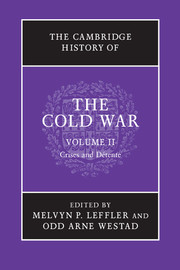Book contents
- Frontmatter
- 1 Grand strategies in the Cold War
- 2 Identity and the Cold War
- 3 Economic aspects of the Cold War, 1962–1975
- 4 The Cuban missile crisis
- 5 Nuclear competition in an era of stalemate, 1963–1975
- 6 US foreign policy from Kennedy to Johnson
- 7 Soviet foreign policy, 1962–1975
- 8 France, “Gaullism,” and the Cold War
- 9 European integration and the Cold War
- 10 Détente in Europe, 1962–1975
- 11 Eastern Europe: Stalinism to Solidarity
- 12 The Cold War and the transformation of the Mediterranean, 1960–1975
- 13 The Cold War in the Third World, 1963–1975
- 14 The Indochina wars and the Cold War, 1945–1975
- 15 The Cold War in the Middle East: Suez crisis to Camp David Accords
- 16 Cuba and the Cold War, 1959–1980
- 17 The Sino-Soviet split
- 18 Détente in the Nixon–Ford years, 1969–1976
- 19 Nuclear proliferation and non-proliferation during the Cold War
- 20 Intelligence in the Cold War
- 21 Reading, viewing, and tuning in to the Cold War
- 22 Counter-cultures: the rebellions against the Cold War order, 1965–1975
- 23 The structure of great power politics, 1963–1975
- 24 The Cold War and the social and economic history of the twentieth century
- Bibliographical essay
- Index
- References
12 - The Cold War and the transformation of the Mediterranean, 1960–1975
Published online by Cambridge University Press: 28 September 2010
- Frontmatter
- 1 Grand strategies in the Cold War
- 2 Identity and the Cold War
- 3 Economic aspects of the Cold War, 1962–1975
- 4 The Cuban missile crisis
- 5 Nuclear competition in an era of stalemate, 1963–1975
- 6 US foreign policy from Kennedy to Johnson
- 7 Soviet foreign policy, 1962–1975
- 8 France, “Gaullism,” and the Cold War
- 9 European integration and the Cold War
- 10 Détente in Europe, 1962–1975
- 11 Eastern Europe: Stalinism to Solidarity
- 12 The Cold War and the transformation of the Mediterranean, 1960–1975
- 13 The Cold War in the Third World, 1963–1975
- 14 The Indochina wars and the Cold War, 1945–1975
- 15 The Cold War in the Middle East: Suez crisis to Camp David Accords
- 16 Cuba and the Cold War, 1959–1980
- 17 The Sino-Soviet split
- 18 Détente in the Nixon–Ford years, 1969–1976
- 19 Nuclear proliferation and non-proliferation during the Cold War
- 20 Intelligence in the Cold War
- 21 Reading, viewing, and tuning in to the Cold War
- 22 Counter-cultures: the rebellions against the Cold War order, 1965–1975
- 23 The structure of great power politics, 1963–1975
- 24 The Cold War and the social and economic history of the twentieth century
- Bibliographical essay
- Index
- References
Summary
If one takes a long-term view of the Mediterranean region between 1960 and 1975, it is characterized by its transition from one defined by the European colonial system and menaced by Soviet encroachment to one that became, fifteen years later, a vital conduit of communication and a channel for shipping Middle Eastern oil into a wider world dominated by the United States. The convergence of Mediterranean history with the global dynamics of the Cold War inspires the consideration of the longue durée. From the early decades of the eighteenth century, the Russian Empire had exerted continuous pressure from the Black Sea toward the Mediterranean. The Soviet Union inherited this geostrategic imperative. The messy decolonization of the Ottoman Empire in the Middle East and the Balkans in the early part of the twentieth century, and subsequently that of European empires in Northern Africa after World War II, added further complexity to the region. As a result, newly independent Mediterranean states faced the problem of developing foreign and commercial policies compatible with their own interests while recognizing the influence of often distant naval powers that dominated their coasts. During the period considered here, the global rivalry of the two superpowers – with the United States always being the strongest, with unprecedented capabilities to project its power – gradually imposed itself on complicated regional dynamics with roots going back to the ancient world.
- Type
- Chapter
- Information
- The Cambridge History of the Cold War , pp. 238 - 257Publisher: Cambridge University PressPrint publication year: 2010
References
- 6
- Cited by



